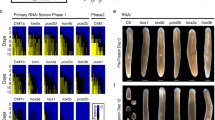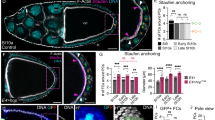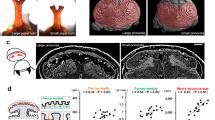Abstract
THE segments in long germ-band insect embryos, like Drosophila, are all determined at syncytial blastoderm stage. This is in contrast to short germ-band embryos which show an early determination of only the anterior head segments, whereas the more posterior thoracic and abdominal segments are sequentially added after formation of a primary germ anlage (reviewed in ref. 1). Segment formation in Drosophila involves the pair-rule genes which define double segmental periodicities2,3 and which have been considered to represent a special adaptation to the long germ-band type development4,5, hairy belongs to the primary pair-rule genes in Drosophila which are directly regulated by the gap genes, such as Krüppell6–13. We have isolated the orthologues of hairy and Krüppel from the flour beetle Tribolium castaneum which has a short germ type development14. We show here that hairy is expressed in several stripes at blastoderm stage and later on in two stripes in the growth zone of the developing embryo. Krüppel expression overlaps hairy stripe three and four expression, very similar to Drosophila. This suggests that the segment patterning mechanism that acts in an open blastoderm in Drosophila works in a similar way in the cellularized Tribolium embryo.
This is a preview of subscription content, access via your institution
Access options
Subscribe to this journal
Receive 51 print issues and online access
$199.00 per year
only $3.90 per issue
Buy this article
- Purchase on SpringerLink
- Instant access to full article PDF
Prices may be subject to local taxes which are calculated during checkout
Similar content being viewed by others
References
Sander, K. Adv. Insect Physiol. 12, 125–238 (1976).
Nüsslein-Volhard, C. & Wieschaus, E. Nature 287, 795–801 (1980).
Ingham, P. Nature 335, 25–34 (1988).
Patel, N., Ball, E. & Goodman, C. Nature 357, 339–342 (1992).
Akam, M. & Dawes, R. Curr. Biol. 2, 395–398 (1992).
Ingham, P. W., Howard, K. R. & Ish-Horowicz, D. Nature 318, 439–445 (1985).
Ingham, P. W., Ish-Horowicz, D. & Howard, K. EMBO J. 5, 1659–1665 (1986).
Hooper, K. L., Parkhurst, S. M. & Ish-Horowicz, D. Development 107, 489–504 (1989).
Howard, K. & Struhl, G. Development 110, 1223–1231 (1990).
Pankratz, M. et al. Cell 61, 309–317 (1990).
Riddihough, G. & Ish-Horowicz, D. Genes Dev. 5, 840–854 (1991).
Preiss, A., Rosenberg, U. B., Kienlin, A., Seifert, E. & Jäckie, H. Nature 313, 27–32 (1985).
Gaul, U., Seifert, E., Schuh, R. & Jäckle, H. Cell 50, 639–647 (1987).
Stanley, M. S. M. & Grundmann, A. W. Ann. ent. Soc. Am. 63, 1248–1256 (1970).
Rosenberg, U. B. et al. Nature 319, 336–339 (1986).
Sommer, R. J., Retzlaff, M., Goerlich, K., Sander, K. & Tautz, D. Proc. natn. Acad. Sci. U.S.A. 89, 10782–10786 (1992).
Rushlow, C. et al. EMBO J. 8, 3095–3103 (1989).
Brown, S. J., Henry, J. K., Black IV, W. C. & Denell, R. E. Insect. Biochem. 20, 185–193 (1990).
Tautz, D. & Pfeifle, C. Chromosoma 98, 81–85 (1989).
Krause, G. Biol. Zbl. 59, 495–536 (1939).
Counce, S. J. A. Rev. Entomol. 6, 295–312 (1961).
Patel, N. H. et al., Cell 58, 955–968 (1989).
Pankratz, M. J. & Jäckle, H. Trends Genet. 6, 287–292 (1990).
Tautz, D., Trick, M. & Dover, G. Nature 322, 652–656 (1986).
Treier, M., Pfeifle, C. & Tautz, D. EMBO J. 8, 1517–1525 (1989).
Saiki, R. K. et al. Science 239, 487–491 (1988).
Sokoloff, A. The Biology of Tribolium (Clarendon, Oxford, 1972).
Patel, N. & Goodman, C. S. in Non-radioactive Labelling and Detection of Biomolecules (ed. Kessler, C.) 377–381 (Springer, Heidelberg, 1992).
Author information
Authors and Affiliations
Rights and permissions
About this article
Cite this article
Sommer, R., Tautz, D. Involvement of an orthologue of the Drosophila pair-rule gene hairy in segment formation of the short germ-band embryo of Tribolium (Coleoptera). Nature 361, 448–450 (1993). https://doi.org/10.1038/361448a0
Received:
Accepted:
Issue Date:
DOI: https://doi.org/10.1038/361448a0



